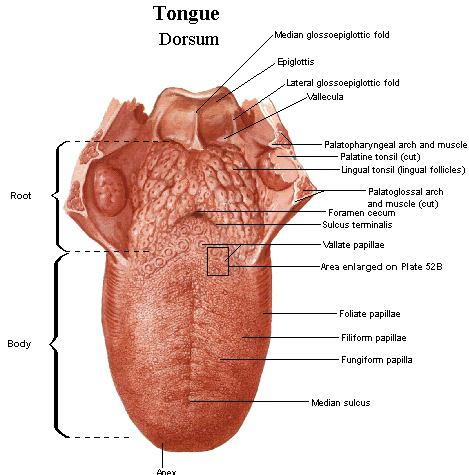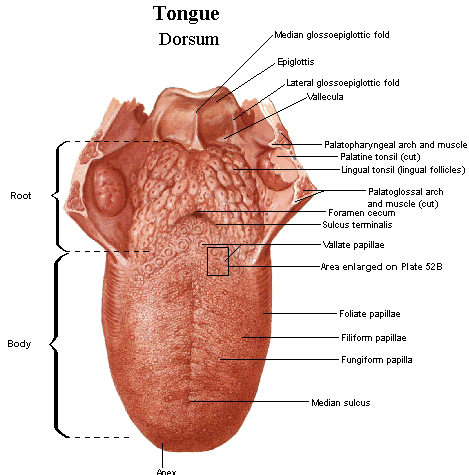TONGUE ACTIVITY

TONGUE ACTIVITY
The tongue provides its own support. The tongue can be divided into three distinct parts, as shown on this picture, which gives the dorsal view of the tongue. The root is is the portion of the tongue that extends along the pharynx. The body of the tongue is the major mass of the tougue, and the tip, or apex, is the part of the tongue nearest the front teeth.
Much of the information about tongue movement is derivedfrom lateral view x-ray, so we have information on its up and down movements in the mouth, but not much information on its left/right movements.
Traditionally, tongue activity is described in a phonetic framework. The production of vowels is described in terms of tongue height and tongue advancement in the mouth. For consonants, tongue location is important. Is the tongue between the teeth, at the alveolar ridge, or soft palate for example? And the degree of constriction caused by the tongue is also important, for example, in the case of fricatives. Do the following matching exercise to practice what you know about tongue location.

One theory relevant to tongue movement is the quantal theory first proposed by K. N. Stevens at the Massachusetts Institute of Technology in 1989. Basically, in some regions of the vocal tract, there are small differences in articulator positioning that lead to large acoustic differences. The flip side is that in other regions of the vocal tract, large differences in articulator positioning lead to small differences in acoustic output. This theory is still being tested. Vowels require more constant tongue shapes compared to consonants. You can not get the same vowel if you change the shape of the tongue. To make a vowel, you are moving the entire tongue mass around the oral cavity. For vowel production, the tongue is moving like a piston in the oral cavity. In contrast, consonants require more fine and rapid adjustments in terms of positioning and shape. We don't see vowel misarticulations in the clinic. Consonant production requires more skill.
Tongue movement for vowels is on a continuum, as is shown in the picture to the right. The picture is from page 107 of your textbook, figure 5.25. Each movement of the tongue produces a different vowel.
The tongue tip is used to produce half of all English consonants. In regard to tongue tip elevation, the tongue is either touching or approaching the alveolar ridge. In retroflex sounds, you ar not really bending your tongue back--it's more like the tip of your tongue points upward. Try it in the /r/ in "water." There is another /r/, the "bunched" /r/, that is not retroflex. This is the /r/ in "race." Even though one is bunched and the other is retroflexed, in both productions, the constriction in the oral cavity is near the alveolar ridge.
There have not been many EMG studies on tongue muscle activity. There is a tremendous amount of interdigitation among the muscle fibers of the tongue, so EMG studies would get a lot of sampling from several muscles simultaneously. There have been quite a few computer modeling studies of the tongue. In the picture to the right, you can see the superior longitudial muscle. And there have been a lot of studies on tongue strength. Many of these studies have used the Iowa oral performance instrument, or IOPI.



